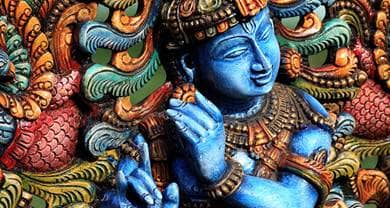- Trending:
- Pope Leo Xiv
- |
- Israel
- |
- Trump
- |
- Social Justice
- |
- Peace
- |
- Love

RELIGION LIBRARY
Hinduism
Worship and Devotion in Daily Life
Perhaps the most common religious act in Hinduism is puja, which is often translated simply as "worship." It literally means "honor." This is important, because the practice of and beliefs behind puja involve not just a formal veneration of the gods and goddesses, but also the entering into a particular sort of relationship. Puja involves the reception, honoring, and in a sense the entertaining of the deity; in puja, a personal relationship, often a very affectionate relationship, is formed.
 Pujas are performed at a variety of different levels—from the simple pujas performed in the home to elaborate and more formal temple pujas. Fundamentally, puja involves bhakti, in that one must approach and treat the god with selfless love; indeed, this is the way in which bhakti is most typically put into practice. Significantly, this love is thought to flow both ways: the devotee loves the god, and the god also loves the devotee.
Pujas are performed at a variety of different levels—from the simple pujas performed in the home to elaborate and more formal temple pujas. Fundamentally, puja involves bhakti, in that one must approach and treat the god with selfless love; indeed, this is the way in which bhakti is most typically put into practice. Significantly, this love is thought to flow both ways: the devotee loves the god, and the god also loves the devotee.
A typical temple puja might involve the following steps:
- An image, or murti, is first clothed in rather common garments.
- Then music is played, mantras are recited, and the plain clothes are removed. In a sense, the deity is not yet present in the image; the image is simply an empty receptacle. The image is prepared to be bathed, first by being rubbed down with various liquids. It is then bathed with water that has been specially sanctified by having mantras chanted.
- Now that it is bathed, and thus purified, the image is adorned, and re-dressed with particularly fine clothes, given a sacred thread, perfumed, and bejeweled and decked with flowers.
- The priest or priests then invoke the god, reciting sacred verses and mantras, essentially inviting him or her to inhabit the image.
- The god, having now inhabited the image, is offered food.
- All of this is typically performed behind a screen, and thus out of sight of the people gathered in the temple for the ritual. The screen is then finally removed, and the act of darshan (or darshana) takes place. Darshan is a particularly significant part of the puja ritual; it is the moment when the god literally sees the human, and also when the human sees the god. There is, however, much more at play here than simple vision, because this involves not simply the physical act of seeing, as in sight, but seeing in the sense of being in the presence of and having a relationship with another being. (Similarly, in English, one says "I saw John," meaning "I saw him, I talked with him, I spent time with him . . .," or "I see what you mean," in the sense of "I understand you.") The moment when the screen is removed in the puja ritual is thus a moment of intense devotion (bhakti), and in some temples devotees do not look directly at the deity because such an initial vision is thought to be too powerful, but instead at a mirror reflecting the god or goddess.
- As one of the final acts in the puja ritual, the priest will take a lamp, called the arati lamp, to the devotees gathered in the temple, who cup their hands over the flame and then touch their eyes and faces, symbolically bringing the light and warmth of the god into themselves.
- Finally, the priests will distribute Prasad, a word that literally means "grace." When the gods are invited into the human realm, they are, among other things, fed. The leftover food is the prasad, and it is understood to be a gift from the gods. This partaking of prasad is symbolically highly significant, in that in this context we humans eat the same food of the gods, and thus are, in a sense, equal to them. Typically, however, leftover food in the Hindu context is highly polluting; thus as much as the partaking of the prasad places us on the same level of the gods, it also demonstrates that we are hierarchically lower than they are–we eat their leftovers. The significance of prasad is thus very complex. It is at once a symbol of the grace and compassion of the god, a symbol of the merging of the human and the deity, and a marker that humans are always inferior to the gods.
Many Hindus perform less formal puja rituals on a daily basis. A family might have a shrine to their special god or gods (or goddesses) in a part of their home. Some families have one such deity, called an ishtadevata (literally "chosen god"), or many. There are pujas that are typically performed in the morning, on special occasions, and before particular journeys or endeavors.
 An illustrative example of these more domestic pujas is the puja performed to the god Ganesh. He is the elephant-headed son of Shiva who is known in many contexts as the "remover of obstacles." As such, he is invoked in a variety of contexts: in the marriage rituals (he removes domestic problems); by school children and college students before taking exams (he removes hard questions); and by taxi drivers, bus drivers, and people purchasing new vehicles (he removes obstacles that might lead to accidents).
An illustrative example of these more domestic pujas is the puja performed to the god Ganesh. He is the elephant-headed son of Shiva who is known in many contexts as the "remover of obstacles." As such, he is invoked in a variety of contexts: in the marriage rituals (he removes domestic problems); by school children and college students before taking exams (he removes hard questions); and by taxi drivers, bus drivers, and people purchasing new vehicles (he removes obstacles that might lead to accidents).
 There are, literally, thousands of what might be called domestic rituals in Hinduism, rituals that are directed to specific gods and intended to positively influence specific activities. Many Hindus, for instance, begin each day with a purifying ritual bath in a sacred river such as the Ganges, or the chanting of a set of sacred hymns, or the recitation of some sacred text. Some of these take place in a public sphere, such as a temple, and involve the participation of priests, while many others are quite private rituals performed at home. All pujas, from the most formal temple ritual to the most informal domestic ritual, are motivated by and permeated with one essential element: bhakti, loving devotion, a sentiment that flows from the worshipper to the deity, and from the deity to the worshipper.
There are, literally, thousands of what might be called domestic rituals in Hinduism, rituals that are directed to specific gods and intended to positively influence specific activities. Many Hindus, for instance, begin each day with a purifying ritual bath in a sacred river such as the Ganges, or the chanting of a set of sacred hymns, or the recitation of some sacred text. Some of these take place in a public sphere, such as a temple, and involve the participation of priests, while many others are quite private rituals performed at home. All pujas, from the most formal temple ritual to the most informal domestic ritual, are motivated by and permeated with one essential element: bhakti, loving devotion, a sentiment that flows from the worshipper to the deity, and from the deity to the worshipper.
Study Questions:
1. How does the ritual of puja help form a personal relationship with a deity?
2. How does prasad unite humans with the gods? How does it create a hierarchy of separation?
3. Who can participate in puja? Who can perform it?










